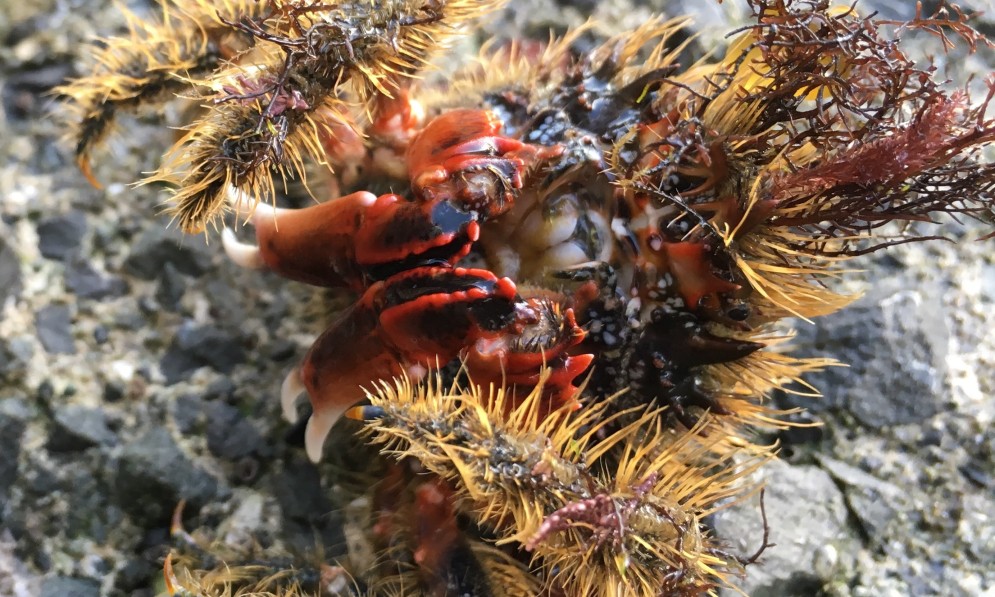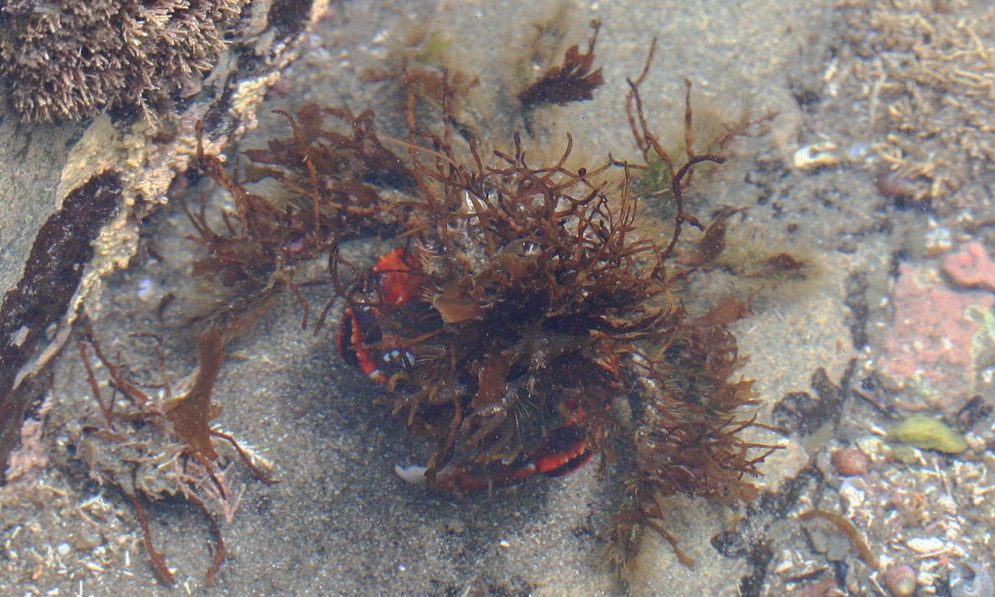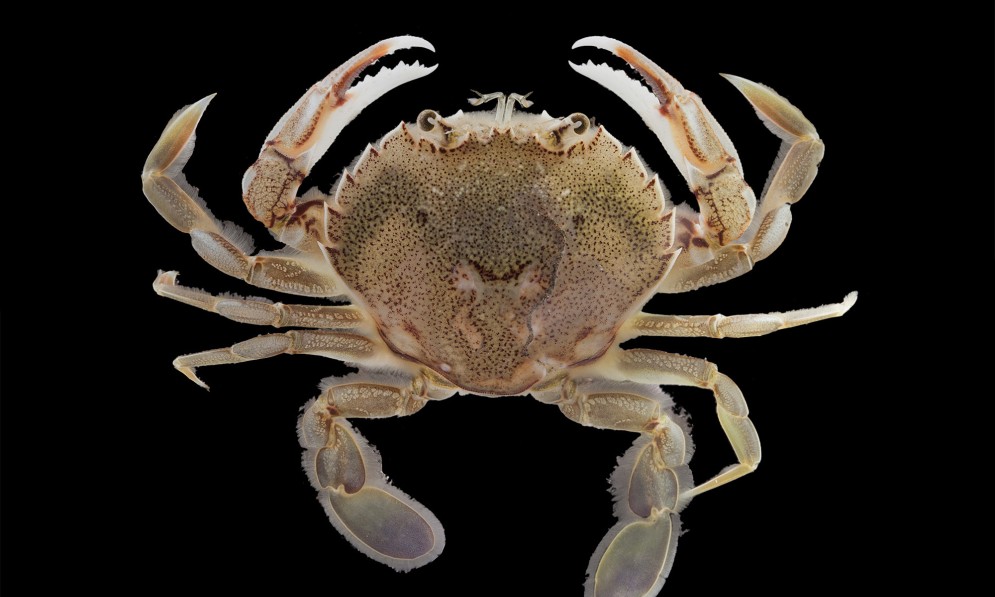Youth Creature Feature [June 2025]

Interior designers have nothing on this underwater feng shui geomancy.
By Jasmine Starr
Have you ever seen a decorator crab? Well…can you be sure?
Decorator crabs are found across the coastlines of the world. They stick plants, rocks, coral, algae, and/or other (smaller) crabs to themselves, camouflaging into their native habitat. They are an incredibly creative family and have been known to disguise themselves using anything from rocks to anemones to disembodied feather star arms.
Many of them have very self-explanatory English names. There’s the sponge decorator crab, which decorates itself in sponges. The soft coral crab, which covers itself in bits of coral. The reef decorator crab, topped with coral and creatures from its local reef. Aotearoa’s very own decorator is covered with hair and camouflages itself using seaweed. You’ll never guess what we called it.
The hairy seaweed crab is covered with long, thick bristles (called hooked setae) that act just like velcro, gathering algae and other flotsam. They’re only 5 cm long and would fit easily in the palm of your hand. Not that you should pick them up—you don’t want to distress wild animals, or get your hands pinched.

The Hairy Seaweed Crab, moments from inspiring a World of Wearable Art costume. Credit: Nick Wilson, Wikipedia, CC BY-SA 4.0.
Hairy seaweed crabs have glorious reddish-orange claws tipped with white, although they mostly use them to decorate. They use their pincers to stick any seaweed they come across to their velcro hairs. Sometimes these underwater florists will carefully snip off a seaweed stem, impaling the flat edge on their setae so it can stick straight into the air.
Fast fashion can’t keep up with the hairy seaweed crab—in style, or in speed. It is constantly working on its disguise, rearranging, adding, and getting rid of outdated seaweed. These crabs change their decor continuously, replacing 10-20% of their disguise every 24 hours. When researchers moved decorator crabs into different environments, they all immediately stuck new materials to their shells, camouflaging perfectly into their new surroundings.
But for all that they change, hairy seaweed crabs may play favourites. After a couple months—sometimes less, if the water is warm—they grow too big and moult, shedding their shells. But they’re attached to their decor in more ways than one and will often transfer pieces of seaweed and sponge to their new shell instead of starting anew.

The Hairy Seaweed Crab: World champion of Peek-A-Boo. Credit: Nuytsia@Tas on Flickr, CC BY-NC-SA 2.0.
Hairy seaweed crabs aren’t the only species that benefit from their seaweed disguise—other creatures shelter on its back. Sponges, worms, snails, and smaller crustaceans live amongst the foliage, appreciating the shelter and the slow ride.
And a hairy seaweed crab’s top speed is incredibly slow. This is another disguise mechanism—seaweed and substrate doesn’t crawl around, so this crab moves slowly enough that it can barely trip your motion sensors. When threatened, its primary instinct is to freeze, so it’s almost completely indistinguishable from the seaweed-covered rocks around it.
Camouflage and low speed aren’t the hairy seaweed crab’s only defenses. During the day, they bury themselves up to their eyestalks, digging a hole with their pincers by pushing sand away from them and sinking down. In gravel or pebble areas, the hairy seaweed crab will pick up rocks in their claws one by one, plopping them an arm’s length away and settling into the gap.
But you can’t blame hairy seaweed crabs for all this hiding—their main predator is terrifying.

The pāpaka: any rational being’s worst nightmare. Credit: Daan Hoffmann, iNaturalist via Wikimedia, CC BY-SA 4.0.
The pāpaka, a massive crustacean, can grow up to 15 centimetres across—3 times as large as the hairy seaweed crab! Pāpaka have spikes on their face, eyespots all over, and a streamlined body with paddlelike legs that let it shoot through the water like a rocket. It’s incredibly aggressive, and when it’s not eating other species, it enjoys partaking in cannibalism. The pāpaka also eats algae, worms, and some molluscs, all of which can live on the hairy seaweed crab’s back. If I was a hairy seaweed crab, I would spend my life hiding, too.
Despite their clever camouflage techniques, hairy seaweed crabs have been spotted across Aotearoa’s coastlines, including Rakiura Stewart Island and Wharekauri (the Chatham Islands). They are often found in the North Taranaki Bight, Dunedin’s Orokonui Ecosanctuary, around Wellington harbour, and clustered around the Kaikōura peninsula. Take a closer look at clumps of rocky seaweed—it could be a crab, collecting its camouflage right under your nose.
Youth Creature Feature is your monthly dose of Aotearoa New Zealand's wacky, whimsical, and wonderful native and endemic species.
Want to get in touch?
Maybe you'd like us to write for you. Or you'd like to write for us?
Contact: Forest & Bird Youth Editors
